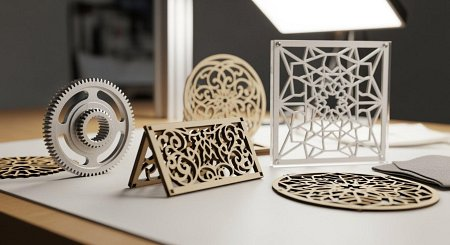It allows the production of complex parts with a level of precision that conventional methods usually cannot achieve, at high speed and with minimal material waste. These advantages make laser cutting an integral part of the manufacturing of the future.
This technology can process various materials such as metals, plastics, wood, and textiles with great precision. The process is particularly efficient when laser cutting sheet metal and ensures clean results.
With constantly new technology, automation and artificial intelligence, the range of applications continues to grow and sets higher standards in quality and speed.
Laser cutting: Important technology for modern production
How does laser cutting work?
Laser cutting is a process in which a focused laser beam is directed into the material to cut it precisely. The beam is concentrated on a small spot, where it melts or vaporizes the material with intense heat. A gas stream (usually nitrogen or oxygen) blows off any residue from the cut, leaving a clean edge.
The laser power and settings are determined by the machine and material. This precise control allows even complex shapes and fine details to be cut cleanly. The combination of powerful energy and precise control makes laser cutting a versatile and efficient tool.
How does laser cutting differ from traditional methods?
Unlike methods such as milling, sawing, or punching, the laser operates without contact. While conventional techniques require direct contact and tools, the laser cuts without pressure or movement on the workpiece. This prevents tool wear and avoids deformation of the part.
Laser cutting also ensures very high levels of precision and repeatability. The cuts are smooth and usually burr-free, eliminating the need for complex rework. This saves time and money while improving quality. The method is also flexible with different materials and thicknesses, offering a wide range of possibilities.
Technical developments in laser cutting
There have been many innovations in laser cutting in recent years. Modern fiber lasers cut faster and consume less power than older CO2 lasers. They offer sharper cuts and are particularly good for metals like stainless steel and aluminum.
A lot has also happened in software. Machines now use artificial intelligence and machine learning to adapt many processes independently. This helps avoid errors, saves time, and increases productivity. Machines can optimize their work independently, making them even more reliable.
BudExpert continuously invests in state-of-the-art laser technology and optimizes its IT systems to increase work efficiency and minimize downtime. With 20 years of experience in metalworking, we combine proven expertise with innovative technologies to consistently deliver the best possible results to our customers.
Advantages of laser cutting compared to other methods
Precision and repeatability
Laser cutting stands for extremely high precision. Cuts can be made to within a fraction of a millimeter. This is particularly useful for delicate and complex shapes that would be virtually impossible with conventional techniques. This results in components that precisely meet specifications.
Another advantage is that identical shapes can be cut exactly the same time and time again. This is especially important in series production because it significantly reduces waste. Industries such as medical technology and electronics benefit greatly from this.
Material variety and flexibility
Laser cutting can process many materials, including various metals (such as steel, stainless steel, aluminum, copper, brass), plastics, wood, textiles, and even ceramics. This versatility gives manufacturers numerous options in design and manufacturing.
Laser cutting is also flexible when it comes to material thickness. It can process thin sheets or thicker plates without compromising quality. This makes the method suitable for individual pieces, small batches, and large production runs – quick changes are no problem, and time-consuming tool changes are eliminated.
| Material | Suitable for laser cutting? |
| Steel / stainless steel |  |
| Aluminium |  |
| copper / brass |  |
| Plastic (e.g. PMMA, polycarbonate) |  |
| Wood |  |
| textiles |  |
| Ceramics (partially) |  |
| PVC (use with caution) |  (only with extraction) (only with extraction) |
High speed and efficiency
Laser cutting systems work quickly, often significantly faster than conventional machines. The thin beam means they cut through very little material, allowing for high processing speeds. Many work steps can even be automated one after the other.
Faster processing times mean shorter delivery times for customers. Companies can respond more flexibly to orders and maximize production capacity. Combined with automation, laser cutting becomes even more productive.
Little material loss and environmentally friendly
A major advantage is that laser cutting produces hardly any material waste. The cutting gaps are very narrow, so more of the expensive raw material remains. This not only saves money but also protects the environment.
The clean cut edges eliminate the need for rework. Fewer work steps mean less energy and material required for surface finishing. Combined with software for better material utilization, resource conservation is further improved.
Good opportunities for automation and digitalization
Laser cutting machines can be easily integrated into automated production processes. They can handle material feeding, cutting, and removal. Especially in large series, this eliminates many manual interventions and ensures consistent quality.










